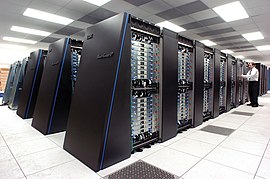 A Blue Gene/P supercomputer at Argonne National Laboratory | |
| Developer | IBM |
|---|---|
| Type | Supercomputer platform |
| Release date | BG/L: Feb 1999 BG/P: June 2007 BG/Q: Nov 2011 |
| Discontinued | 2015 |
| CPU | BG/L: PowerPC 440 BG/P: PowerPC 450 BG/Q: PowerPC A2 |
| Predecessor | IBM RS/6000 SP; QCDOC |
| Successor | Summit, Sierra |

Blue Gene was an IBM project aimed at designing supercomputers that can reach operating speeds in the petaFLOPS (PFLOPS) range, with relatively low power consumption.
The project created three generations of supercomputers, Blue Gene/L, Blue Gene/P, and Blue Gene/Q. During their deployment, Blue Gene systems often led the TOP500[1] and Green500[2] rankings of the most powerful and most power-efficient supercomputers, respectively. Blue Gene systems have also consistently scored top positions in the Graph500 list.[3] The project was awarded the 2009 National Medal of Technology and Innovation.[4]
After Blue Gene/Q, IBM focused its supercomputer efforts on the OpenPower platform, using accelerators such as FPGAs and GPUs to address the diminishing returns of Moore's law.[5][6]
- ^ "November 2004 - TOP500 Supercomputer Sites". Top500.org. Retrieved 13 December 2019.
- ^ "Green500 - TOP500 Supercomputer Sites". Green500.org. Archived from the original on 26 August 2016. Retrieved 13 October 2017.
- ^ "The Graph500 List". Archived from the original on 2011-12-27.
- ^ Harris, Mark (September 18, 2009). "Obama honours IBM supercomputer". Techradar.com. Retrieved 2009-09-18.
- ^ "Supercomputing Strategy Shifts in a World Without BlueGene". Nextplatform.com. 14 April 2015. Retrieved 13 October 2017.
- ^ "IBM to Build DoE's Next-Gen Coral Supercomputers - EE Times". EETimes. Archived from the original on 30 April 2017. Retrieved 13 October 2017.